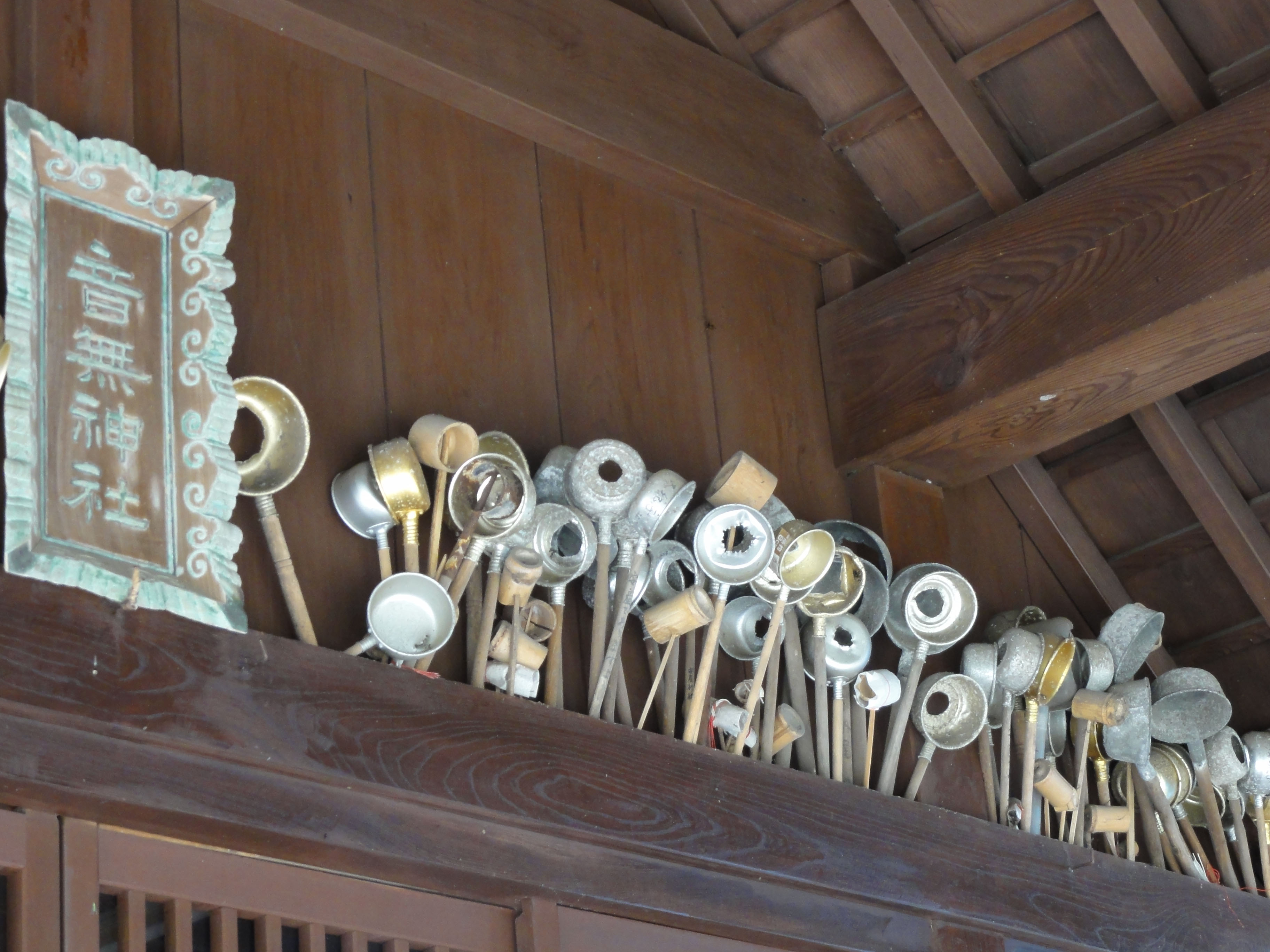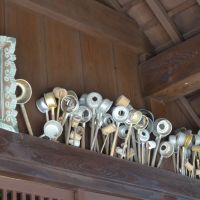Dear Alice,
My friend and I stumbled upon something mysterious on the Izu Peninsula. We were walking along the picturesque Matsukawa River, where it runs through the town of Ito, when we came upon a shrine with no one about. It looked like any other small-town shrine, except that over the doorway, stuck upright into the lintel, was a whole line of broken down water ladles! They were the metal sort you use to wash your hands at the stone basins at shrines. But here's the weird thing: every one of them had a huge hole in the bottom! So, what the heck is that? The final resting place for decrepit dippers?
Monique S., Hamamatsu, Shizuoka Prefecture
Dear Monique,
I hope you won't mind if I ask a personal question: By any chance, are either you or your friend expecting a baby? Because if you are, you may have stumbled onto your ticket to a quick and easy birth. Bear with me, and I'll explain.
First of all, I got the scoop on your shrine by calling the tourist information office in Ito City. You were at Otonashi Shrine, which enjoys a measure of fame, I learned, because of a butt-bumping, bottom-pinching festival held every year on Nov. 10. You may want to mark your calendar for this event, at which pairs of contestants stand back to back on an overturned wooden tub and try to bump each other off using only their bums. But the main observance occurs when visitors mingle in complete darkness, silently passing cups of sacred sake. To signal the next person to take the cup, you pinch their bottom, which is why the festival is called the Shiritsumi Matsuri. ("Shiri" means "buttocks," and "tsumi" is a pinch or nip).
This was all very interesting, but when I was finally able to guide the lady on the line back to the question of ladles, she explained that those ladles are generally called hishaku. If their nether regions have gone missing, however, they become sokonuki (punch-bottom) hishaku. I followed this much with no problem, but then she seemed to say that the shrine is decorated with punch-bottom ladles because pregnant women bring them there. Excuse me? "Oh yes," she said. "It's a form of anzan kigan," (praying for a safe and easy birth).
I've given birth but I couldn't see the connection between leaky ladles and express deliveries, so I asked for the logic. "Water passes easily through a scoop with no bottom, right? So in offering a bottomless scoop to the shrine," she explained, "women pray that their baby will pass from their bodies just as easily." When I asked if this custom is widespread, she said she wasn't aware of any other place in the country where bottomless ladles are used as part of safe-birth prayers.
But when I dipped a little deeper, I found that ladles are offered elsewhere as well. The most interesting example I found was a shrine in Minobu, Yamanashi Prefecture, where bottomless ladles, stuck upright in the ground, dot the hillside around a building housing gods that look out for women in labor. According to a sign there, a photo of which I found on the Internet, devotions are linked to a legend about a traveling monk who was passing through the area when a young couple approached him for help. The wife was having a difficult pregnancy, and they were concerned that the birth wouldn't go well. The monk advised them to prepare a ladle with no bottom, and when a healthy baby boy was born to them, the couple dedicated the ladle to the shrine. For hundreds of years, people from the area and well beyond have come to offer bottomless ladles for a safe birth.
This legend should not be confused, however, with yet another involving sokonuki hishaku. (Who knew there were so many?) This second legend concerns a particularly vengeful sea monster known as Umi-bozu. According to coastal folklore and various Edo Period tales, Umi-bozu appears to sailors at sea demanding the sort of ladle used for bailing out boats. If the crew is foolish enough to indulge him, he ladles the boat full of seawater and sinks it. But if they refuse, he goes into a rage and capsizes them. The only way to beat Umi-bozu, according to the legend, is to trick him by giving him a ladle that has been rendered harmless by first removing its bottom.
But let's get back to babies: The far more common form of anzan kigan is to visit one of the many of shrines and temples around the country associated with safe birth and buy a special sash. It's called a haraobi and is wrapped around the expectant mother's abdomen to protect mother and child. You can also bring your own and get it blessed and purified.
The most common time to go for safe-birth prayers is after a woman enters her fifth month of pregnancy, and on one of the two or three days designated in each month as Inu no Hi (Day of the Dog). Dogs are believed to give birth with little pain or complication, so they're practically the patron pet of pregnant women in Japan. You see doggie designs on almost everything associated with birth, and every website I've seen for expectant mothers posts a chart of dog days for the year. (In October, the 10th and the 22nd are both Inu no Hi.). It's common for relatives to go along for anzan kigan, and often a mother or mother-in-law will offer prayers at least once on the expectant mother's behalf.
Probably the most famous place to pray for safe birth is the Suitengu shrine in Tokyo, but there are shrines and temples all over the country that specialize in safe birth and other aspects of women's health and well being. Other well-known destinations around the country include the Karamatsu Shrine in Daisen, Akita Prefecture; the Gansuiji Temple in Hamakita, Shizuoka Prefecture; and the Nakayama Temple in Takarazuka, Hyogo Prefecture.
To learn more about safe-birth devotions in Japan, and catch the scene at Suitengu shrine on a busy Day of the Dog, visit my blog at alicegordenker.wordpress.com. As a bonus, I've posted a photo of the dipper fields at the shrine in Minobu. Puzzled by something you've seen? Ask away to [email protected] or A&E Dept., The Japan Times, 5-4, Shibaura 4-chome, Minato-ku, Tokyo 108-8071.



















With your current subscription plan you can comment on stories. However, before writing your first comment, please create a display name in the Profile section of your subscriber account page.